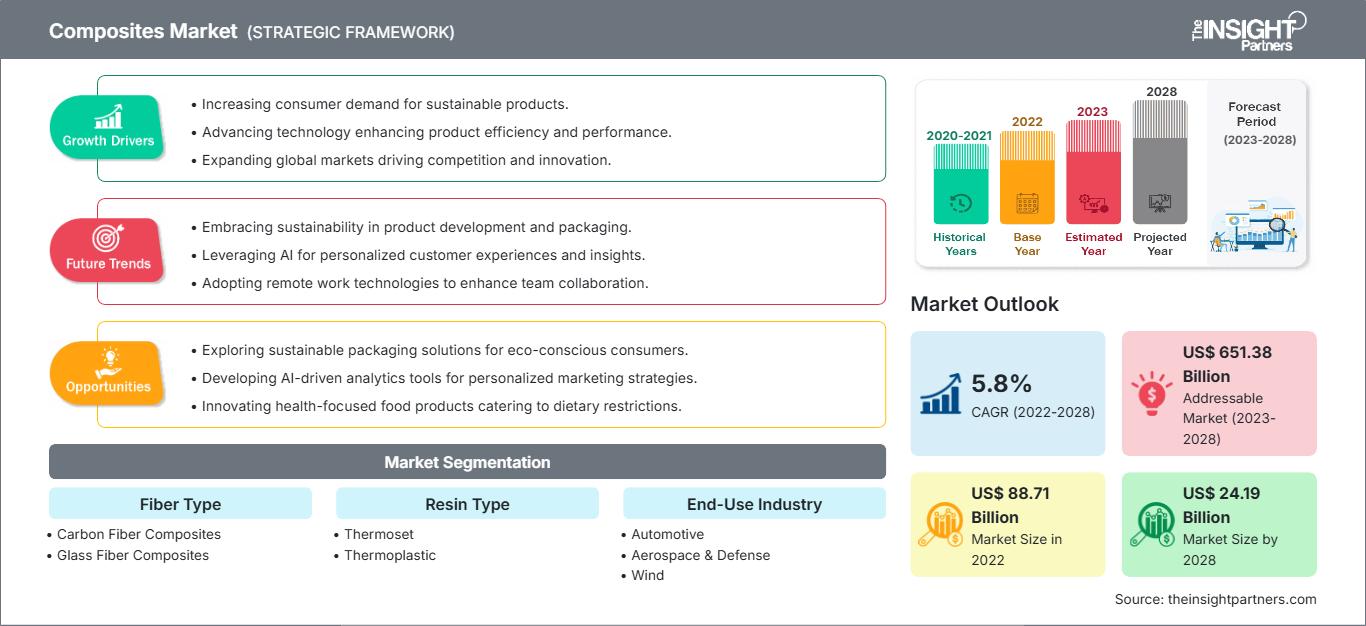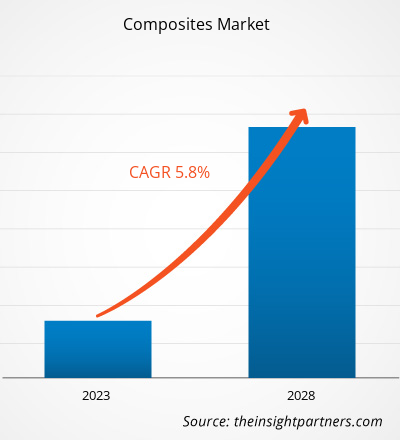The composites market size is expected to grow from US$ 88,710.42 million in 2022 to US$ 124,185.35 million by 2028; it is estimated to grow at a CAGR of 5.8% from 2022 to 2028.
Composites are light in weight as compared to most woods and metals. The lightweight property of composites makes their usage important in automobiles and aircraft, where less weight offers better fuel efficiency. Nowadays, designers of airplanes are greatly concerned with weight, as reducing a craft’s weight reduces the amount of fuel it needs and increases the speed it can reach. Moreover, composites resist damage from the weather and harsh chemicals. They can be molded into complicated shapes more easily than most other materials.
In 2022, Asia Pacific held the largest revenue share of the global composites market. The demand for composites in Asia Pacific is increasing due to the growing use of composites in various end-use industries such as automotive, wind energy, construction, sporting goods, and many others. The growing building & construction industry is a strong contributor to the composites market growth in the region. Asia Pacific is witnessing urbanization, along with the rising construction of residential and commercial projects. Moreover, the per capita income in the region has increased, coupled with the development of affordable residential buildings. This has resulted in rapid urbanization in Asia Pacific. The beneficial government policies related to residential property developments in several countries of the region propelled urbanization. Moreover, countries such as China and India are amongst the world’s top five countries with installed wind power. All these factors positively contribute to the composites market growth in the region.
Customize This Report To Suit Your Requirement
You will get customization on any report - free of charge - including parts of this report, or country-level analysis, Excel Data pack, as well as avail great offers and discounts for start-ups & universities
Composites Market: Strategic Insights

-
Get Top Key Market Trends of this report.This FREE sample will include data analysis, ranging from market trends to estimates and forecasts.
Impact of COVID-19 Pandemic on Composites Market
Industries such as automotive, aerospace, construction, marine, and energy have been the major contributors to the demand for composites. In 2020, these industries had to slow down their operations due to disruptions in the value chain caused by the shutdown of national and international boundaries. The shortage of manpower resulted in the deceleration of composite production and distribution operations. Disruptions in the global supply chain and shutdown of resin production facilities led to a severe spike in the prices of composites. Lockdowns imposed by different countries in 2020 hampered the ability of industries to maintain inventory levels. Moreover, sanitary measures and other COVID-19 precautions significantly reduced production capacity, creating a shortage of composite inventory. However, in 2021, the global marketplace began recovering from the losses incurred in 2020 as governments of different countries announced relaxation in social restrictions. Moreover, rising vaccination rates contributed to improvements in the overall conditions in different countries, which led to conducive environments for industrial and commercial progress. According to the World Economic Forum, the COVID-19 pandemic has the potential to bring innovations in home designs and is expected to provide new opportunities in the field of house renovation. This factor is projected to provide lucrative opportunities for the composites market growth during the forecast period.
Market Insights
Increasing Demand for Lightweight Materials from Automotive & Aerospace Industry
Automotive manufacturers prefer lightweight materials for manufacturing automobiles while ensuring safety and performance. Lightweight materials have excellent potential for increasing fuel efficiency. A 10% decrease in vehicle weight can result in a 6–8% enhancement in fuel economy. Advanced materials such as carbon fiber composites have the potential to reduce the weight of automotive components by 50-75%. The application of composites in the automotive sector continues to grow. Plastic composites have excellent acoustic and thermal properties compared to composites of nonrenewable origin, making them ideal for vehicle’s interior parts. Further, they are suitable for the manufacturing of non-structural interior components, including seat fillers, seat backs, headliners, interior panels, and dashboards. In addition, aircraft manufacturers are making efforts to enlarge primary thermoplastic structures in business jets and commercial aircraft. They have been the early adopters of long fiber-reinforced thermoplastics.
Fiber Type Insights
Based on fiber type, the global composites market is segmented into carbon fiber composites, glass fiber composites, and others. The global composites market share for the glass fiber composites segment was the largest in 2022. Glass fiber composites are produced by various manufacturing technologies and are used for a wide range of applications. Glass fibers showcase several properties, namely, high strength, flexibility, durability, and resistance to chemical damage. It can be in the form of roving, chopped strands, yarns, fabrics, and mats. Each type of glass fiber has distinct properties and is used for various applications in the form of polymer composites. Glass fiber composite materials are highly preferred for industrial applications due to their favorable characteristics such as high strength-to-weight ratio, good dimensional stability, good resistance to heat & corrosion, good electrical insulation properties, ease of fabrication, and relatively low cost.
The key players operating in the global composites market include DuPont de Nemours Inc, Gurit Holding AG, Hexion Inc, Mitsubishi Chemical Holdings Corp, Nippon Electric Glass Co Ltd, Owens Corning, SGL Carbon SE, Teijin Ltd, Solvay SA, and Toray Industries Inc. Players operating in the global composites market focus on providing high-quality products to fulfill customer demand. They are also focusing on strategies such as investments in research and development activities and new product launches.
Report Spotlights
- Progressive industry trends in the composites market to help players develop effective long-term strategies
- Business growth strategies adopted by developed and developing markets
- Quantitative analysis of the composites market from 2020 to 2028
- Estimation of global demand for composites
- Porter’s Five Forces analysis to illustrate the efficacy of buyers and suppliers operating in the industry
- Recent developments to understand the competitive market scenario
- Market trends and outlook, as well as factors driving and restraining the growth of the composites market
- Assistance in the decision-making process by highlighting market strategies that underpin commercial interest, leading to the market growth
- The composites market size at various nodes
- Detailed overview and segmentation of the market, as well as the composites industry dynamics
- The composites market size in various regions with promising growth opportunities
The regional trends and factors influencing the Composites Market throughout the forecast period have been thoroughly explained by the analysts at The Insight Partners. This section also discusses Composites Market segments and geography across North America, Europe, Asia Pacific, Middle East and Africa, and South and Central America.
Composites Market Report Scope
| Report Attribute | Details |
|---|---|
| Market size in 2022 | US$ 88.71 Billion |
| Market Size by 2028 | US$ 24.19 Billion |
| Global CAGR (2022 - 2028) | 5.8% |
| Historical Data | 2020-2021 |
| Forecast period | 2023-2028 |
| Segments Covered |
By Fiber Type
|
| Regions and Countries Covered |
North America
|
| Market leaders and key company profiles |
|
Composites Market Players Density: Understanding Its Impact on Business Dynamics
The Composites Market is growing rapidly, driven by increasing end-user demand due to factors such as evolving consumer preferences, technological advancements, and greater awareness of the product's benefits. As demand rises, businesses are expanding their offerings, innovating to meet consumer needs, and capitalizing on emerging trends, which further fuels market growth.

- Get the Composites Market top key players overview
Global Composites Market
Based on fiber type, the global composites market is segmented into carbon fiber composites, glass fiber composites, and others. Based on resin type, the global composites market is bifurcated into thermoset and thermoplastic. The thermoset segment is further segmented into polyester, vinyl ester, epoxy, polyurethane, and others. The thermoplastic segment is subsegmented into polypropylene, polyethylene, polyvinylchloride, polystyrene, polyethylene terephthalate, polycarbonate, and others. Based on end-use industry, the global composites market is segmented into automotive, aerospace & defense, wind, construction, marine, sporting goods, and others.
Company Profiles
- DuPont de Nemours Inc
- Gurit Holding AG
- Hexion Inc
- Mitsubishi Chemical Holdings Corp
- Nippon Electric Glass Co Ltd
- Owens Corning
- SGL Carbon SE
- Teijin Ltd
- Solvay SA
- Toray Industries Inc.
Frequently Asked Questions
What are the key drivers for the growth of the global composites market?
Based on end-use industry, which is the fastest-growing segment in the composites market?
What are the opportunities for composites in the global market?
What is the largest region of the global composites market?
Can you list some of the major players operating in the global composites market?
Based on the fiber type, why does the glass fiber composites segment have the largest revenue share?
- Historical Analysis (2 Years), Base Year, Forecast (7 Years) with CAGR
- PEST and SWOT Analysis
- Market Size Value / Volume - Global, Regional, Country
- Industry and Competitive Landscape
- Excel Dataset
Recent Reports
Testimonials
Reason to Buy
- Informed Decision-Making
- Understanding Market Dynamics
- Competitive Analysis
- Identifying Emerging Markets
- Customer Insights
- Market Forecasts
- Risk Mitigation
- Boosting Operational Efficiency
- Strategic Planning
- Investment Justification
- Tracking Industry Innovations
- Aligning with Regulatory Trends





















 Get Free Sample For
Get Free Sample For